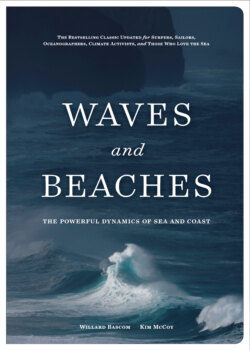Читать книгу Waves and Beaches - Kim McCoy - Страница 28
На сайте Литреса книга снята с продажи.
THE FORCES OF GRAVITY, BUOYANCY, AND VISCOSITY
ОглавлениеIt is important to keep in mind three fundamental forces that exist in every ocean wave, and form every beach. Gravity, buoyancy, and viscosity are three forces that struggle for dominance as they eternally flirt and dance with each other. Their presence is essential for the motion of waves and the paths of sediments.
Gravity is attractive; think of it as the universe’s charisma. Gravity attempts to pull all matter toward a center, causing galaxies to form and comets to crash, propelling a surfer down the slope of a wave. Gravity is what causes tides to rise, waves to undulate, and a grain of sand to resist fluid motion. Amazingly, humans can describe gravity but have yet to agree on what causes it.
Buoyancy is an uplifting force. Think of buoyancy as lighthearted and youthful; it makes things lighter when the mood gets heavy. Buoyancy pushes back against gravity’s pull. The buoyant force is what causes objects to float. It is asserted in all fluids, liquids, and gases alike. An object that is lighter than its surrounding fluid will move upward, whereas the object that is heavier will sink. When the buoyant force is equal to the gravitational force, an object becomes neutrally buoyant, drifting freely, neither up nor down. But it rarely lasts. Each grain of sediment in an offshore sandbar, every cobble, and every boulder gets buoyed by the uplifting force of its surrounding water.
Viscosity is the stickiness of the universe as energy spreads out. The viscous force comes forth as any fluid tries to resist flow. When there is movement, there is friction. The amount of friction in a fluid (i.e., viscous force) is linked to the shear; that is, when there are relative speeds within a fluid. Viscosity causes individual grains of sand to start moving beneath a wave, it mobilizes large stones, and is inherent in the drag forces that restrain the movements of tides, ships, and surfers. Viscous forces can be great enough to overwhelm both gravity and buoyancy.
Understanding the twirling dance of gravity, buoyancy, and viscosity is important. Together they influence a grand cascade of energy: the movement of planets, the heat from the Sun, the direction of atmospheric winds, the motion of ocean currents, and the formation of waves. These forces, all active within waves, even appear as the small-scale turbulent saltation (from saltus, “leap” in Latin) for each grain of sand. Our waves and beaches are the exhibition of a dynamic act, performed on a moving “dance floor” propelled by wind, tide, and climate.
Knowing what we know, and full of confidence that we understand waves both in theory and by actual test, we fling open the laboratory door, stride to the edge of the cliff, and look to the sea. Good grief! The real waves look and act nothing like the neat ones that endlessly roll down the wave channel or march across the blackboard in orderly equations. These waves are disheveled, irregular, and moving in many directions. No alignment can be seen between a series of crests; some of the crests actually turn into troughs while we are watching them. Should we slink back inside to our reliable equations and brood over the inconsistencies of nature? Never! Instead we must become outdoor wave researchers. And that means getting wet, salty, cold—and confused.
